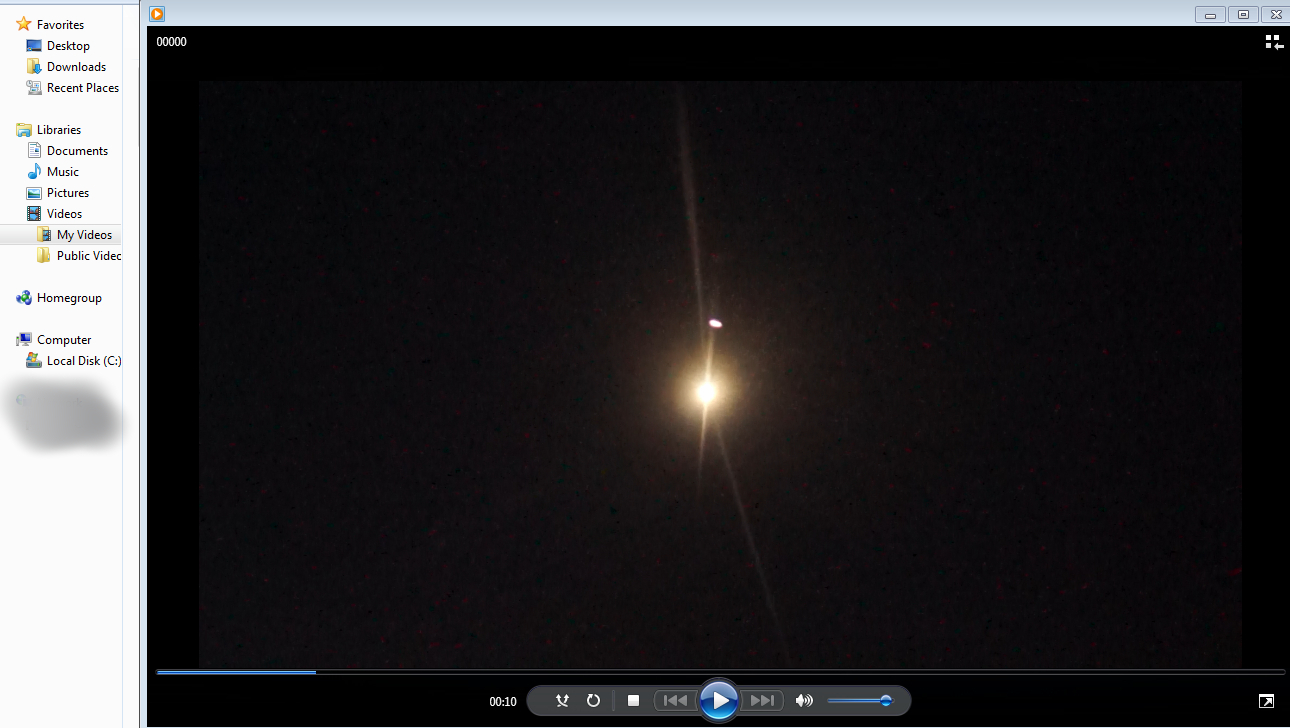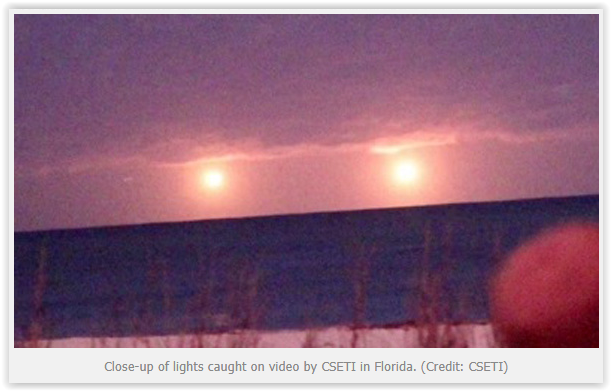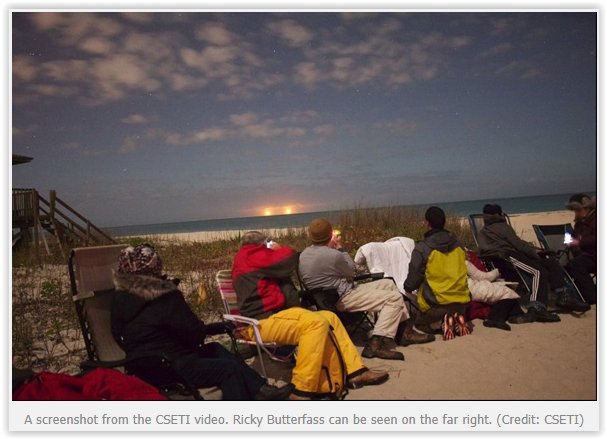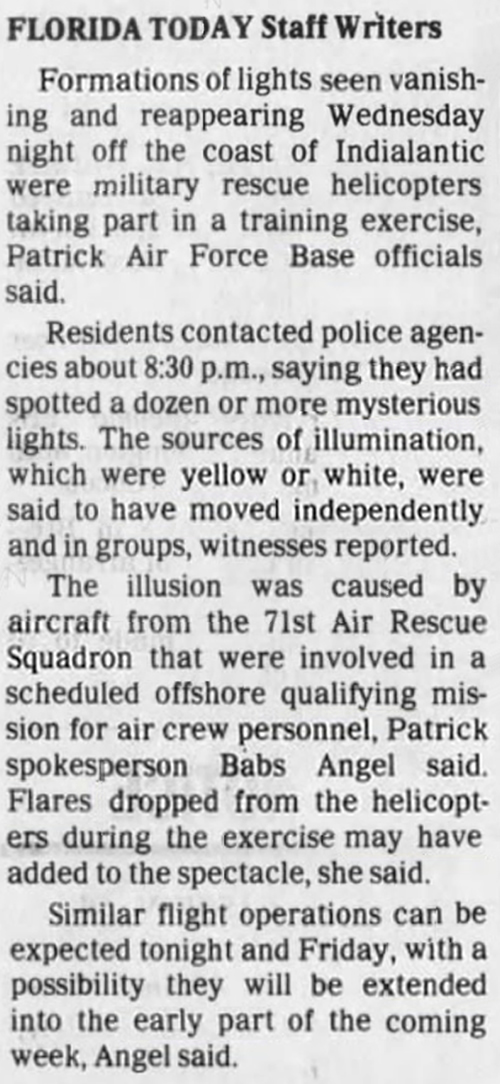It looks like you're using an Ad Blocker.
Please white-list or disable AboveTopSecret.com in your ad-blocking tool.
Thank you.
Some features of ATS will be disabled while you continue to use an ad-blocker.
share:
a reply to: elevenaugust
in my opinion, your examples are by no means relative to the footage in my OP.
i don't really think it's a credible hypothesis, and i don't think that you've made a good case for it. if the objects are truly as far away as you believe, how can they be so bright? aperture and exposure settings? no, this is nonsense.
the aperture and exposure settings would not only apply to the lights, but obviously the rest of the image as well. if they're truly that far away, but are being captured so brightly, then you would see the same saturated effects for anything else in the shot that's creating or reflecting light - and that's exactly what's not happening.
please show me one example of a flare that resembles the footage in my OP. if the visual conditions that you're referring to are truly typical and easily observed, then this really shouldn't be a challenge for you.
in my opinion, your examples are by no means relative to the footage in my OP.
Then, there’s nothing that discard the idea that they might be further away, rendering thus credible the parachute flare hypothesis.
i don't really think it's a credible hypothesis, and i don't think that you've made a good case for it. if the objects are truly as far away as you believe, how can they be so bright? aperture and exposure settings? no, this is nonsense.
the aperture and exposure settings would not only apply to the lights, but obviously the rest of the image as well. if they're truly that far away, but are being captured so brightly, then you would see the same saturated effects for anything else in the shot that's creating or reflecting light - and that's exactly what's not happening.
please show me one example of a flare that resembles the footage in my OP. if the visual conditions that you're referring to are truly typical and easily observed, then this really shouldn't be a challenge for you.
a reply to: wmd_2008
i have years of experience with digital tape, editing and production in a scholastic and private setting as well. i'm confident that i'm not stepping into any pitfalls, nor making any assumptions. they don't look like flares, and you'd be hard pressed to find a good example of a flare that resembles that footage. i'm honestly a bit surprised at how persistently you guys are holding onto this inadequacy with literally no relative examples to cite.
If you watched that video you would have seen examples that I have mentioned above, also consider this many of us on here are long time amatuer photographers we even have a few professionals many have been taking pictures way longer than some members have been alive and know the pitfalls and assumtions people can make.
i have years of experience with digital tape, editing and production in a scholastic and private setting as well. i'm confident that i'm not stepping into any pitfalls, nor making any assumptions. they don't look like flares, and you'd be hard pressed to find a good example of a flare that resembles that footage. i'm honestly a bit surprised at how persistently you guys are holding onto this inadequacy with literally no relative examples to cite.
edit on 3-1-2018 by facedye because: added content
originally posted by: facedye
a reply to: elevenaugust
in my opinion, your examples are by no means relative to the footage in my OP.
Then, there’s nothing that discard the idea that they might be further away, rendering thus credible the parachute flare hypothesis.
i don't really think it's a credible hypothesis, and i don't think that you've made a good case for it. if the objects are truly as far away as you believe, how can they be so bright? aperture and exposure settings? no, this is nonsense.
the aperture and exposure settings would not only apply to the lights, but obviously the rest of the image as well. if they're truly that far away, but are being captured so brightly, then you would see the same saturated effects for anything else in the shot that's creating or reflecting light - and that's exactly what's not happening.
please show me one example of a flare that resembles the footage in my OP. if the visual conditions that you're referring to are truly typical and easily observed, then this really shouldn't be a challenge for you.
So you have years of experience yet aperture and exposure settings confuse you lets have a look at another example a couple of stills from from a video I took just to show this issue.
The part I underlined above total BS and shows you don't have a clue.
I saw a bright light in the sky but could hear exactly what it was, so I took my camera which had a 70-300 mm zoom on it and took a short video using settings from using it earlier that day this was the result.
Your typical bright light in the sky.

Then go to manual for exposure this is the result.

The local Police helicopter. See what you claimed underlined above is so wrong if you do editing for a living NEVER venture to the other side of the camera
As for the comments re the brightness of the lights I would be 99.99999% cetain the camcorder was on automatic exposure very few had manual options and most people wouldn't know how to use them you certainly wouldn't. Most would use average exposure for a light level reading from a large part of the frame which is darker than the lights so guess what the lights get over exposed.
So claiming they don't look like flares because you compare it to videos taken at different distance, exposure & equipment is a bit of a joke for someone that claims to know what they are taking about.
originally posted by: facedye
If the objects are truly as far away as you believe, how can they be so bright? aperture and exposure settings?
Aperture, ISO and exposure settings were taken as an example in my airliner photo, in reply to you saying:
originally posted by: facedye
you're using a lightbulb as a comparison to a flare?
And...
originally posted by: facedye
This "low quality camcorder" that we're talking about was able to capture lights *presumably* about 20 miles away with way more intensity and clarity than that HD photo you posted.
... explaining what could be one cause (or several causes among many others) of the visual difference (hue, light intensity, etc...).
These object are so bright simply because they are able to emit 1.6 million candela, which is incredibly powerful.
originally posted by: facedye
please show me one example of a flare that resembles the footage in my OP.
No need to exactly reproduce the flare visual appearance to validate the point; that was already largely done several posts before with several parachute flare samples, as seen from far away, with no visible smoke trails.
The thing that can be compared is the candela value of similar light emitted from different objects to that of the parachute flare, i-e for example the landing light halogen bulb of an airliner or the light bulb of a lighthouse. You can refer to my previous posts for the examples and distances involved, all of these being fully consistent with the parachute flare MUFON video
If you still need nonetheless closests examples (taken during daylight, with same visual aspect, etc. in spite of what I've said relatively to the suspicion one should have about what is seen with naked eyes) of such parachute, then you can check further this example:
- The 2015 CSETI video.


What's interesting is that Mr Butterfass used the same arguments as yours (smoke trail and parachute not visible), to which others photos analyst (far more well-known than me) replied:
- Bruce Maccabee, an optical physicist who used to work for the U.S. Navy at the Naval Surface Warfare Center in Virginia, was of the opinion that the lights in the video are flares.
- Marc Dantonio, the chief photo analyst for the Mutual UFO Network (MUFON) said this:
“The facts are this. You see one appear in another way they appear is from right to left. The way they go out is from right to left as expected, with the first one to light up being the first one to go out. Not only that but you can actually see as you scrub through the video that they drift to the right and sink lower in the sky. It is at that point where the first flare that lit up then goes out as expected. This is absolutely consistent with aerial parachute flares.”
Related ATS thread.
edit on 3-1-2018 by elevenaugust because: (no reason
given)
a reply to: wmd_2008
no, not confused one bit i simply disagree with you.
do you see how the rest of the night sky changes as well when you edited the image? that's what i'm referring to when i'm talking about the aperture and exposure being applied to the entire image, instead of just the lights in question.
So you have years of experience yet aperture and exposure settings confuse you lets have a look at another example a couple of stills from from a video I took just to show this issue.
no, not confused one bit i simply disagree with you.
The local Police helicopter. See what you claimed underlined above is so wrong if you do editing for a living NEVER venture to the other side of the camera
do you see how the rest of the night sky changes as well when you edited the image? that's what i'm referring to when i'm talking about the aperture and exposure being applied to the entire image, instead of just the lights in question.
edit on 3-1-2018 by facedye because: (no reason
given)
a reply to: elevenaugust
this is a hilarious perspective. if you can't give me a similar video example of what you're talking about, you simply don't have an argument that stands up any better than a house of cards. you're guessing based on your past experience.
No need to exactly reproduce the flare visual appearance to validate the point; that was already largely done several posts before with several parachute flare samples, as seen from far away, with no visible smoke trails.
this is a hilarious perspective. if you can't give me a similar video example of what you're talking about, you simply don't have an argument that stands up any better than a house of cards. you're guessing based on your past experience.
originally posted by: facedye
a reply to: wmd_2008
So you have years of experience yet aperture and exposure settings confuse you lets have a look at another example a couple of stills from from a video I took just to show this issue.
no, not confused one bit i simply disagree with you.
The local Police helicopter. See what you claimed underlined above is so wrong if you do editing for a living NEVER venture to the other side of the camera
do you see how the rest of the night sky changes as well when you edited the image? that's what i'm referring to when i'm talking about the aperture and exposure being applied to the entire image, instead of just the lights in question.
You said this as well.
the aperture and exposure settings would not only apply to the lights, but obviously the rest of the image as well. if they're truly that far away, but are being captured so brightly, then you would see the same saturated effects for anything else in the shot that's creating or reflecting light - and that's exactly what's not happening.
Cameras have various metering modes my DSLR has the following
Multi segmented which takes 1200 readings from around the frame.
Then Center Weighted again takes readings all around the frame but with a bias towards the central area of the frame
Lastly Spot Metering a small circle indicated in the viewfinder no other area measured.
So with the video in the OP most cameras on that type would have average metering and as the lights are a small area of the frame guess what it exposes for the sky and the lights get over exposed yes its that simple.
The frames I took from my video using my Sony Camera which was done in live view and has an electronic viewfinder so I could see the effect of the exposure and guess what make sure the subject could be seen, that's why manual exposure and even focusing is better in low light unless you have really top spec camera.
This link below is a Nikon P900 zooming in on the Moon look at the colour of the sky before it zooms in as the exposure is measured for the scene, then as it zooms in and the bright Moon starts to fill the screen look at the sky become under exposed because it exposes for the Moon.
There are also other issues when lights are over exposed , quality of the equipment and also youtube itself.
Could be someone trying to start a new UFO religion, and in that case what is the motive?
Even UFO's like dyson swarms and space fountains might have some value captivating imagination.
There was federal funding for the space fountain technology.
Space tether systems actually worked.
These kinds of sightings are usually just a focusing mechanism that limits public attention, a dis/info.
They always seem to want to construct Dyson spheres at 1 Astronomical unit which means there would be a longitudinal Berlin wall circumscribing the Earth.
I don't know who the intended audience is, but these threads seem to get ignored by people because they seem too preposterous and are easily debunked.
Even UFO's like dyson swarms and space fountains might have some value captivating imagination.
There was federal funding for the space fountain technology.
Space tether systems actually worked.
These kinds of sightings are usually just a focusing mechanism that limits public attention, a dis/info.
They always seem to want to construct Dyson spheres at 1 Astronomical unit which means there would be a longitudinal Berlin wall circumscribing the Earth.
I don't know who the intended audience is, but these threads seem to get ignored by people because they seem too preposterous and are easily debunked.
a reply to: facedye
So again your argument is based solely on a belief. A belief that has yet to be proven through scientific facts. This is one place we differ, not that there's anything wrong with holding on tight to a belief and feelings, but I don't subscribe to that method of thinking in reference to this phenomena. Especially one that's 70+ years strong with many thousands of claims with still nothing to show in the way of scientific evidence. Because of this, all grounded explanations have to be completely eliminated first. Flares are not eliminated simply because there's no reference through YouTube videos where all conditions are met to give a balanced comparison. You've mistakenly been posting videos of the wrong type of flares and incorrectly making statements like flares "fizzle out quickly." This shows a lack of knowledge, research, and knee jerk response without investigation. Maybe this has something to do with riding the wave of excitement over this "Pentagon UFO" study?
By the way, after doing some deeper research, I was able to find the Florida Today article freely online. In the article it explains residents called in reporting strange lights and so forth. The explanation given was that the 71st Air Rescue Squadron were participating in an offshore training exercise. During the training, flares were dropped by helicopters.

I think that sums it up.
Give me a logical explanation for the lights fading and going out. Alien rheostat lighting?
facedye
"lights fading and going out" is a commonly reported characteristic of UFO sightings.
So again your argument is based solely on a belief. A belief that has yet to be proven through scientific facts. This is one place we differ, not that there's anything wrong with holding on tight to a belief and feelings, but I don't subscribe to that method of thinking in reference to this phenomena. Especially one that's 70+ years strong with many thousands of claims with still nothing to show in the way of scientific evidence. Because of this, all grounded explanations have to be completely eliminated first. Flares are not eliminated simply because there's no reference through YouTube videos where all conditions are met to give a balanced comparison. You've mistakenly been posting videos of the wrong type of flares and incorrectly making statements like flares "fizzle out quickly." This shows a lack of knowledge, research, and knee jerk response without investigation. Maybe this has something to do with riding the wave of excitement over this "Pentagon UFO" study?
By the way, after doing some deeper research, I was able to find the Florida Today article freely online. In the article it explains residents called in reporting strange lights and so forth. The explanation given was that the 71st Air Rescue Squadron were participating in an offshore training exercise. During the training, flares were dropped by helicopters.

I think that sums it up.
edit on 5-1-2018 by Ectoplasm8 because: (no reason given)
a reply to: Ectoplasm8
dude, with all due respect, you're being redundant. all of this information is available in my OP. you're literally just taking the military at their word. this is a blatant appeal to authority. taking their word for it is good enough for you? ok, it's not good enough for me.
this isn't a belief. there are countless documented UFO sightings that explain this same exact behavior. this is valuable to keep in mind. how is that so hard to understand? it's quite literally a typical characteristic of these sightings - where in this concept am i injecting my own beliefs?protip: i'm not. it's simply a consistent behavior with a lot of UFO sightings.
this is pretty funny. every user here, including yourself, has failed to convincingly demonstrate how these could be flares. i've shown you many videos of flares to compare - the video in my OP does not resemble flares.
what about when you brought up the LUU-2 flare as an example? i've compared it to the LUU-19, found comparing information to the LUU-2, and even found a video example of one. they're ridiculously similar in MOST ways, the LUU-19 in fact has a longer drop rate, and does not resemble the footage in my OP in any way.. and yet you still grasp to this illegitimate point of view.
give me a visual example of what you're talking about - you and other members here have gone on and on about how obvious this is, with literally no relative examples to back up your point of view. i was the one to actually find the footage you and others here were referring to, and guess what? doesn't compare one bit.
in my opinion, i think you really need to start thinking outside of the box, and stop thinking that you know the beliefs of other people you've never met.
By the way, after doing some deeper research, I was able to find the Florida Today article freely online. In the article it explains residents called in reporting strange lights and so forth. The explanation given was that the 71st Air Rescue Squadron were participating in an offshore training exercise. During the training, flares were dropped by helicopters.
dude, with all due respect, you're being redundant. all of this information is available in my OP. you're literally just taking the military at their word. this is a blatant appeal to authority. taking their word for it is good enough for you? ok, it's not good enough for me.
So again your argument is based solely on a belief. A belief that has yet to be proven through scientific facts.
this isn't a belief. there are countless documented UFO sightings that explain this same exact behavior. this is valuable to keep in mind. how is that so hard to understand? it's quite literally a typical characteristic of these sightings - where in this concept am i injecting my own beliefs?protip: i'm not. it's simply a consistent behavior with a lot of UFO sightings.
Flares are not eliminated simply because there's no reference through YouTube videos where all conditions are met to give a balanced comparison. You've mistakenly been posting videos of the wrong type of flares and incorrectly making statements like flares "fizzle out quickly."
this is pretty funny. every user here, including yourself, has failed to convincingly demonstrate how these could be flares. i've shown you many videos of flares to compare - the video in my OP does not resemble flares.
what about when you brought up the LUU-2 flare as an example? i've compared it to the LUU-19, found comparing information to the LUU-2, and even found a video example of one. they're ridiculously similar in MOST ways, the LUU-19 in fact has a longer drop rate, and does not resemble the footage in my OP in any way.. and yet you still grasp to this illegitimate point of view.
give me a visual example of what you're talking about - you and other members here have gone on and on about how obvious this is, with literally no relative examples to back up your point of view. i was the one to actually find the footage you and others here were referring to, and guess what? doesn't compare one bit.
in my opinion, i think you really need to start thinking outside of the box, and stop thinking that you know the beliefs of other people you've never met.
edit on 10-1-2018 by facedye because: (no reason given)
new topics
-
It's Offical Now
US Political Madness: 1 hours ago -
The reason it works is.....
General Chit Chat: 1 hours ago -
Dick Van Dyke saved from Wildfire by neighbours on his 99th birthday
People: 4 hours ago
top topics
-
Dick Van Dyke saved from Wildfire by neighbours on his 99th birthday
People: 4 hours ago, 3 flags -
It's Offical Now
US Political Madness: 1 hours ago, 2 flags -
The reason it works is.....
General Chit Chat: 1 hours ago, 1 flags
active topics
-
It's Offical Now
US Political Madness • 4 • : theatreboy -
1 Billion dollars
General Entertainment • 12 • : Blueracer -
London Christmas Market BANS Word ‘Christmas’
Social Issues and Civil Unrest • 41 • : Oldcarpy2 -
Trump says ownership of Greenland 'is an absolute necessity'
Other Current Events • 49 • : Xtrozero -
Can someone 'splain me like I'm 5. Blockchain?
Science & Technology • 97 • : Xtrozero -
NYPD arrests migrant who allegedly set woman on fire on subway train, watched her burn to death
Breaking Alternative News • 53 • : GENERAL EYES -
-@TH3WH17ERABB17- -Q- ---TIME TO SHOW THE WORLD--- -Part- --44--
Dissecting Disinformation • 3809 • : Crazierfox -
The reason it works is.....
General Chit Chat • 0 • : DAVID64 -
Christmas Dinner ??
Food and Cooking • 16 • : Naftalin -
Dick Van Dyke saved from Wildfire by neighbours on his 99th birthday
People • 0 • : gortex
